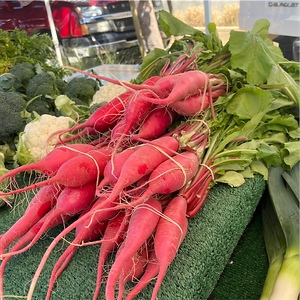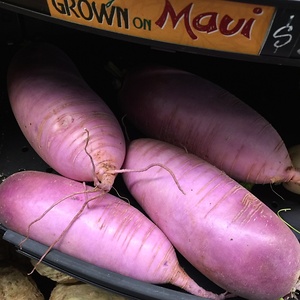


Beni Shigure Daikon Radish
Estimated Inventory, lb : 0
Description/Taste
Beni Shigure daikon radishes are a large variety, averaging 7 to 9 centimeters in diameter and 25 to 26 centimeters in length, and have an elongated, cylindrical, and curved shape tapering to a small point. The skin is firm and semi-smooth, sometimes covered in rough, striated markings, and ranges in color from dark pink to purple on the stem end, developing an ombre appearance as it transitions into a lighter pink or purple hue on the non-stem end. Underneath the surface, the flesh is white, marbled with purple-pink specks and patches, and has a crisp, dense, and crunchy consistency. Beni Shigure daikon radishes have a mild, earthy, and sweet flavor with nutty and subtly spicy undertones.
Seasons/Availability
Beni Shigure daikon radishes are available in the late fall through early winter.
Current Facts
Beni Shigure daikon radishes, botanically classified as Raphanus sativus, are a brightly colored Japanese variety belonging to the Brassicaceae family. Daikon radishes are one of Japan's most popular vegetables and are a versatile ingredient, favored for their mild, slightly sweet flavor. Beni Shigure daikon radishes were created as an improved daikon variety, cultivated for its nutritional content, cold tolerance, extended storage capabilities, and late-season harvest. The radishes are also valued for their pigmented flesh, providing bright hues to appetizers, garnishes, main dishes, and side dishes.
Nutritional Value
Beni Shigure daikon radishes are an excellent source of vitamin C, an antioxidant that strengthens the immune system, boosts collagen production, and reduces inflammation. The radishes are also a good source of potassium to regulate fluid levels within the body, folate to produce genetic material, and contain lowers amounts of copper, calcium, and magnesium. In Japanese natural medicines, the roots are believed to aid in digestion, as the flesh contains a starch degrading enzyme known as diastase. This enzyme helps to convert starch into sugar, stimulating digestion, and is used to prevent heartburn. Beni Shigure daikon radishes are also a rich source of antioxidants, found in the pigmented parts of the flesh, which protects the cells in the body against environmental damage.
Applications
Beni Shigure daikon radishes have a neutral, subtly sweet flavor best suited for both raw and cooked applications. The radishes can be sliced, grated, and chopped for salads, spring rolls, and sushi, used as a topping over soups, or they can be served as a side dish to rice, tempura, and grilled meats. Beni Shigure daikon radishes can also be grated over oily fish or pickled and served as a palate cleanser. Each radish has unique coloring and graining, allowing it to be sliced into different patterns and colors depending on the angle of the cut. In addition to raw applications, Beni Shigure daikon radishes can be sliced into thick pieces and braised with beef or pork, cut and simmered into curries to bring out the vegetable's natural sweetness, or stir-fried, roasted, steamed, or lightly boiled. The leaves of the root can also be cooked and consumed as a nutritious green. Beni Shigure daikon radishes pair well with meats such as pork, poultry, beef, and duck, seafood, lotus root, taro, aromatics, including ginger, garlic, and lemongrass, carrots, artichokes, and celeriac. Whole Beni Shigure daikon radishes will keep up to two weeks when stored in a plastic bag in the refrigerator. If the root comes with the leaves, it is important to remove the leaves as they will continue to pull moisture from the root, creating a dry, corky consistency.
Ethnic/Cultural Info
In Japan, Beni Shigure daikon radishes are primarily pickled to showcase the root’s vibrant coloring. When the flesh is mixed with vinegar, it transforms into a vivid, bright pink and retains its crisp nature, contributing textural and aesthetically pleasing elements to culinary dishes. Pickled vegetables such as radishes are known as tsukemono in Japanese and are a traditional side dish, snack, and garnish, commonly served alongside rice and soup. Tsukemono provides salty, tart, sour, and pungent flavors into meals and helps to balance other sweet, savory, and rich notes within a dish. Japanese food is centered around the idea of balance and believes the meal should incorporate many colors to create harmony. Besides providing flavor, pickled Beni Shigure daikon radishes are used as a palate cleanser and are used to spur digestion. In Japan, the bright pink, pickled radishes are primarily shredded as a side dish, sliced into sticks with salads, or cut into decorative shapes such as flowers and used as an edible garnish.
Geography/History
Daikon radishes have been cultivated since ancient times and were known in Japan sometime before the 4th century. When the plants were first introduced, the fast-growing leaves were the only portion of the plant eaten, but in the Edo period between the 17th and 19th centuries, Japanese farmers began to cultivate daikon radishes for their nutritious, large roots. Daikon radishes quickly became a staple ingredient in Japanese cuisine, and many new daikon radish varieties have been bred over time for improved cultivation, including Beni Shigure daikon radishes. The variety was developed in the Kanagawa prefecture by Tohoku, a Japanese seed company, in partnership with Professor Koichiro Shimomura from Toyo University. Today Beni Shigure daikon radishes are mainly found in Japan and are grown in the Chiba, Hokkaido, and Aomori prefecture.
Recipe Ideas
Recipes that include Beni Shigure Daikon Radish. One









